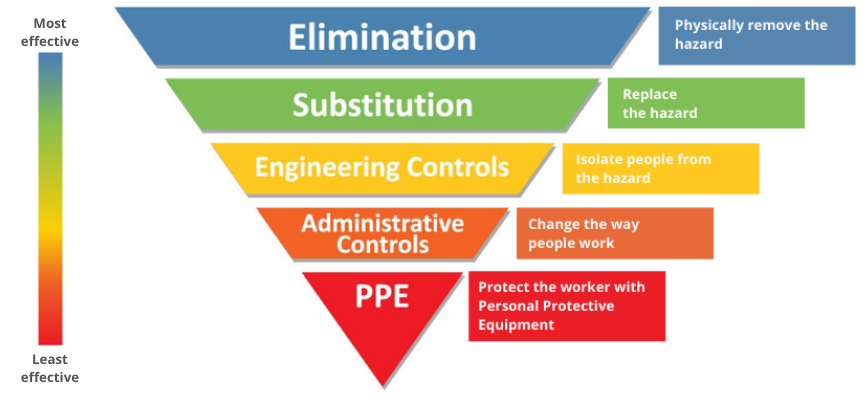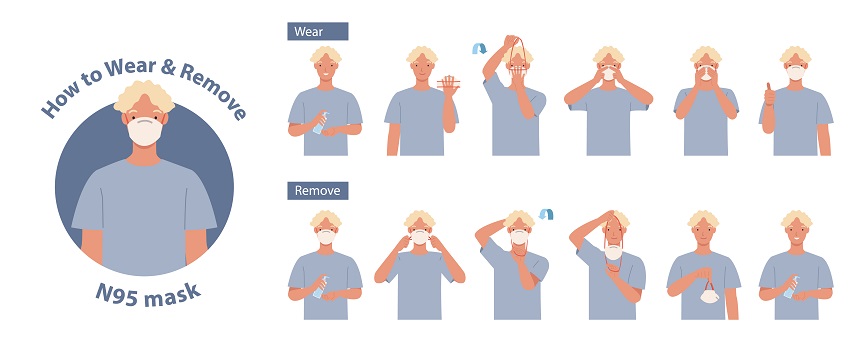What Does Rpe Stand for in Health and Safety
Claudia Calder discusses the what, why and how of using personal protective equipment and respiratory protective equipment to protect against COVID-19.
With the outbreak of COVID-19, there has been a lot of talk about PPE (Personal Protective Equipment) and RPE (Respiratory Protective Equipment). In this article, I explain what these are, why they are used, and how to wear (and dispose) of it properly.
This guidance can be used as part of your Prevent strategy, under the Prepare, Inform, Prevent, Recovery approach to returning to work. Read more about it the approach at the link.
Before we explain what PPE or RPE is and why it is needed to protect ourselves against COVID-19, we need to understand where it fits in with overall safety control measures.
Hierarchy of Controls
Safety experts use a system called "Hierarchy of Controls" to eliminate or minimise exposure to hazards, which ranks the effectiveness and efficiency of hazard controls.
Simply put, it is a system where you start at the top of the hierarchy and try and put in appropriate control measures at each stage, until you have eliminated, or minimised as much as possible, the risk.

Elimination – Physically Remove the Hazard
To eliminate COVID-19 in the population, the virus needs to 'go away'. To do this, a vaccine needs to be developed and administered to the population, so that we are protected from developing the disease from the virus.
There is no way of 'killing' the virus all at once, unless somebody develops an airborne neutralising anti-viral vector, which is currently impossible to do. Sadly, we don't live in the movies!
Substitution – Replace the Hazard
We cannot substitute COVID-19 for something else, however, when cleaning our hands, we can substitute alcohol-based sanitiser, which can cause dermatitis, for soap and water.
Engineering Controls – Isolate people from the hazards
This is the stage where we can start minimising the risk against COVID-19 in the workplace. COVID-19 is transmitted person-to-person through respiratory droplets from coughs and sneezes, and possibly breath.
Which is why advice from the UK Government is to catch your coughs and sneezes in a tissue (or the crease of your elbow) and to keep 2m apart from each other – isolating people from the hazard, which are other people.
Physical engineering controls such as plastic screens have been put in place in shops to protect customer service staff from customers, as well as physical distancing measures. Office environments have also put screens in between workstations to minimise the risk of transmission between workers.
At this stage, we have slightly reduced the risk to the transmission, under certain working environments. So what can we do next to reduce the risk even further?
Administrative Controls – Change the Way People Work
Administrative controls include training, procedure, policy or shift designs that reduce the risk of a hazard to an individual, typically changing the behaviour of people, rather than actually removing the hazard.
As we start to return to work, whether it be in an office or factory or shop, workers are going need to change their behaviour to include washing hands (good hygiene practices) and physical distancing.
This already started to become 'normal' but these messages will need to be reinforced in the workplace, as we will forget to do these things. We need to recognise that our environment sometimes directs our actions – for example, last time we were in the office, we had chats in the kitchen, just got into the lift with whoever. In the COVID-19 world, we just won't be able to do this without thinking of the potential consequences.
Your return to work/COVID-19 risk assessment, will layout what control measures will need to be brought in – if you are struggling with this, please contact our safety consultancy team, we can help you through this process and provide you with an induction program, as well as bespoke documentation for your organisation.
Some considerations to think about include:
- Training your workforce in good hygiene practices, reinforcing these messages with posters, emails and screensavers
- Strengthening the message, that if you have any COVID-19 symptoms (prolonged cough and fever) or have been near people who have these symptoms to stay at home
- Communicating and reinforce your procedures and policies to your workforce through e-learning or alternative communication mediums
- Leading by example
We can also, where possible, work from home instead of working in an office. Some jobs are clearly more suitable for this, but it might be that some work tasks can be done at home, allowing staff to stay at home more often and only going in to the workplace when necessary.
At the end of stage 4, we have now minimised the risk to exposure somewhat, but what about those workers who come into contact with lots of people, such as public transport or frontline work, where the viral load (how much virus is around) is higher than you would expect in a workplace?
Personal Protective Equipment (PPE) – Protect the (Individual) Employee
PPE is the final stage of the hierarchy of controls and is to be used when engineering or administrative controls are not feasible or effective to reduce the risks to acceptable levels.
What is PPE?
PPE stands for Personal Protective Equipment. Its purpose is to protect an individual worker from the hazard – imposing a barrier between the wearer/user and the working environment.
PPE can create additional stress on the user. It can impair the ability to carry out their work and can create significant levels of discomfort – which is one of the reasons that PPE is the final stage of the hierarchy of control.
Examples of PPE are:
- Gloves (to protect the hands)
- Gowns, coats or aprons (to protect the body and clothing)
- Goggles and safety glasses (to protect the eyes)
- Masks, (to protect your respiratory system from what you breathe in) – these are known as RPE (Respiratory Protective Equipment).
There are numerous different types of masks (RPE) available, each of the different types have a different level of protection, depending on the hazard.
RPE is available in different sizes to allow for the facial differences of workers. Gender, ethnicity, build and many other factors mean that one size will not fit everyone – RPE needs to match the specific requirements of the worker.
If you require to wear a mask for work purposes, such as asbestos removal or you are a healthcare worker, these masks should be appropriate for the work and face fitted – what this means, is that the mask is fitted to your face and it has been tested (using smells) to ensure that the seal around the mouth and nose is airtight.
How to Wear and Remove Your FFP2-type (N95) Mask
In a situation where the mask is not for direct exposure to substances, but to minimise the risk of transmission of COVID-19 virus, for example on public transport, where there are lots of people and there is potential to have high viral load, masks should be face-fitted, but it is not going to be possible, then you should follow this guidance for using a FFP2-type (N95 mask).

What, Why and How We Should Use PPE and RPE 2020-06-23 2020-07-01 /us/wp-content/uploads/2016/09/cardinus-2.png Cardinus https://www.cardinus.com/wp-content/uploads/2020/06/shutterstock_1506907316-880x586-1.jpg 200px 200px
What Does Rpe Stand for in Health and Safety
Source: https://www.cardinus.com/insight/covid-19-hs-response/ppe-and-rpe-what-why-and-how/
0 Response to "What Does Rpe Stand for in Health and Safety"
Post a Comment